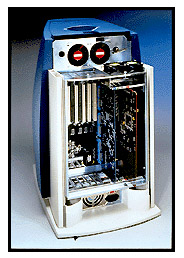| One of the most unconventional system architectures seen
in recent years is coming in a new line of servers and
desktop systems from Panda Project, a start-up based in
Boca Raton, Florida. Panda partitions the traditional
motherboard into three independent boards connected to a
passive backplane by a proprietary high-speed interface.
By separating the CPU, I/O, and main memory into modular
subsystems, Panda says it will offer a level of
upgradability and CPU independence unmatched by
conventional designs. The CPU board includes the microprocessor, secondary cache, primary PCI bus, and related control logic. (For now, Panda is supporting three CPU architectures — Intel x86, DEC Alpha, and soon IBM/Motorola PowerPC — but others could be added in the future.) The I/O board includes system I/O interfaces, such as ISA, SCSI, or a bridge to a second PCI bus. The memory board contains all the DRAM for main memory. These subsystems connect to the backplane with Panda's high-density Compass interface, a panel of 18 152-pin connectors. This architecture allows users or resellers to snap together their own systems with the CPU, I/O interfaces, and memory they want. Panda's first system, the Archistrat 4s server, is expected to debut this fall at $10,490. That's for a 100-MHz Pentium with 32 MB of RAM and a 1-GB hard drive. Alpha CPU boards are planned for later this year, and PowerPC boards based on the PowerPC common hardware platform are expected in mid-1996. Archistrat's modularity lets you start with a Pentium and switch to an Alpha, or vice versa. "It's intellectually satisfying," says Eric Lewis, an analyst at International Data Corp. (Mountain View, CA). "But I don't think most companies are really that interested in switching [CPU] architectures, because then you've got to revamp all your software, too. It seems like a fairly small market." It's also a market pursued by DeskStation Technologies, which last year introduced a motherboard called the UniFlex. The UniFlex segregates the CPU on a daughtercard that supports either an Alpha 21164 or a Mips-compatible R4600 Orion. (Future versions may also support the Alpha 21164A and the PowerPC 620.) DeskStation puts the UniFlex motherboards into its high-end PCs for Windows NT. Panda goes further than DeskStation by partitioning the I/O and memory subsystems as well. Conceivably, you could swap out the memory board to take advantage of faster DRAM technology or change the I/O board if a new bus standard supersedes PCI. DeskStation's vice president of engineering, Blaise Fanning, says Panda's design is philosophically sound but unnecessary in practice, because memory and I/O technologies don't advance as quickly as CPUs. Also, he adds, by the time you upgrade all the subsystems, you might as well purchase a whole new computer: "The only investment you're really preserving is the backplane." Previous passive-backplane designs have also been criticized for their high cost or inadequate bandwidth. Panda says its Compass technology solves these problems. The Compass connectors carry about 650 signals between the CPU and the backplane, but they cost only five cents per mated pair, according to Bruce Smith, Panda's vice president of engineering. BYTE was unable to test a production sample of the Archistrat 4s in time for this article. If nothing else, Panda's modular approach to motherboards is an interesting twist on the system architecture of PCs. Contact: Panda Project, Boca Raton, FL; (800)
892-2892, (407) 994-2300, or fax (407) 994-0191;
sysinfo@archistrat.com. DeskStation Technologies,
Lenexa, KS; (800) 793-3375, (913) 599-1900, or fax (913)
599-4024 http://www.dti.com; sales@dti.com. Time Will Tell if this Panda is an Endangered
Species
Copyright 1994-1998 BYTE |